microsoft MB-260 Exam Questions
Questions for the MB-260 were updated on : Jul 01 ,2025
Page 1 out of 4. Viewing questions 1-15 out of 50
Question 1 Topic 1, Case Study 1Case Study Question View Case
DRAG DROP
You are a Customer Data Platform Specialist. You are implementing an incremental refresh in audience insights. All the data
is stored in an Azure SQL database and is ingested to audience insights using Power Query. You need to configure an
incremental refresh for data sources.
Which four actions should you perform in sequence to meet this requirement? To answer, move the appropriate actions from
the list of actions to the answer area and arrange them in the correct order.
Select and Place: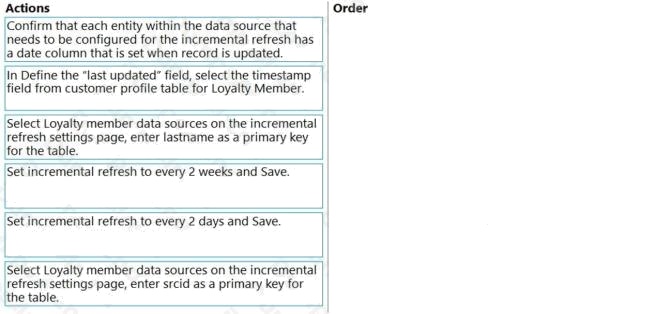
Answer:
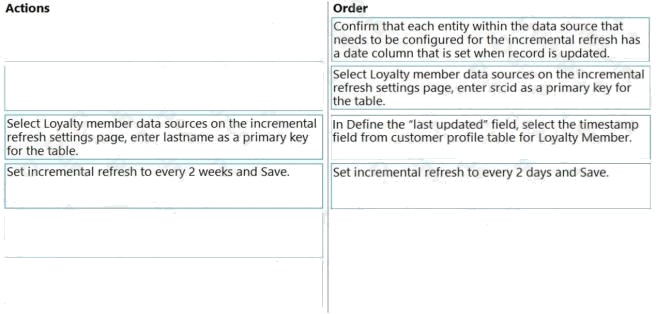
Explanation:
Reference: https://docs.microsoft.com/en-us/dynamics365/customer-insights/audience-insights/incremental-refresh-data-
sources
Question 2 Topic 1, Case Study 1Case Study Question View Case
You are a Customer Data Platform Specialist. The marketing team requested that customer cellphone numbers be added to
the customer profile in audience insights. The customer cellphone numbers are stored in a separate table in the Azure Gen 2
Storage Account.
You decide to create the data source(s) needed in audience insights.
Which statements best describes the steps needed to ingest the required data to audience insights?
- A. In audience insights, under Data, select Data Sources, add data source and select Azure data lake storage as an import method, enter name as Loyalty Cell Phone and enter storage account name to authenticate. Repeat the steps for other tables.
- B. In audience insights, select Data Sources, add data source, enter “CellPhone” in the name field and click Next.
- C. In audience insights, add data source and select Azure data lake storage as an import method, enter cellPhone_loyalty as a data source name, and then enter the container name and method to authenticate. Repeat the same steps for other tables.
- D. In audience insights, add data source and select Microsoft Dataverse as an import method, enter CellPhoneloyalty as a data source name.
Answer:
C
Explanation:
There are three data sources containing customer profile data loaded to a dedicated storage account and container in the
Azure Data Lake. Ingesting Cell phone data- the requirement is to keep the name of the date sources aligned with the
design document. cellPhone_loyaly.csv: srcid (primary key), cellphone
Reference: https://docs.microsoft.com/en-us/dynamics365/customer-insights/audience-insights/connect-power-query
Question 3 Topic 1, Case Study 1Case Study Question View Case
DRAG DROP
You are a Customer Data Platform Specialist. You want to add data sources that connect to data in the organizations Azure
Data Lake. You need to enable data profiling for the entity within the data source while creating it.
Which three actions should you perform in sequence to meet this requirement? To answer, move the appropriate actions
from the list of actions to the answer area and arrange them in the correct order.
Select and Place:
Answer:

Explanation:
Reference: https://docs.microsoft.com/en-us/dynamics365/customer-insights/audience-insights/connect-common-data-model
Topic 2, Case Study 2
Case study
This is a case study. Case studies are not timed separately. You can use as much exam time as you would like to complete
each case. However, there may be additional case studies and sections on this exam. You must manage your time to ensure
that you are able to complete all questions included on this exam in the time provided.
To answer the questions included in a case study, you will need to reference information that is provided in the case study.
Case studies might contain exhibits and other resources that provide more information about the scenario that is described
in the case study. Each question is independent of the other questions in this case study.
At the end of this case study, a review screen will appear. This screen allows you to review your answers and to make
changes before you move to the next section of the exam. After you begin a new section, you cannot return to this section.
To start the case study
To display the first question in this case study, click the Next button. Use the buttons in the left pane to explore the content of
the case study before you answer the questions. Clicking these buttons displays information such as business requirements,
existing environment, and problem statements. When you are ready to answer a question, click the Question button to return
to the question.
General Overview
AdventureWorks Cycles is a bicycle retailer with a few locations in the Midwest region. The AdventureWorks Cycles
business model supports both in store purchases as well as online orders. In addition to offering a wide variety of bicycles,
the company sells clothing, performance nutrition supplements, bicycle parts as well as bicycle fitting and repair services.
The customer base varies from professional cyclists, individual leisure riders to families. The business experienced
unprecedented growth of over 2000% during the pandemic bringing a total number of customers to 10,000. The company
decided to invest in Microsoft Dynamics 365 Customer Insights and Dynamics 365 Sales App to unify customer data and
improve sales.
Data Source
AdventureWorks Cycles uses Customer Insights to connect to data from three different sources to generate a unified
customer record. The data ingestion has been done for the initial data load. There are three data sources containing
customer profile data loaded to a dedicated storage account and container in the Azure Data Lake:
Loyalty data source: This data source contains customer profile information from in-store purchases.
- loyalty.member.csv: srcid (primary key), firstname, lastname, middlename, fullname, addressstreet, loyalty_email, city,
zipcode, state, homephone, datecreated, timestamp
Ecommerce Data source: This data source contains customer profile information from online purchases.
- ecom.member.csv: ecid (primary key), firstname, last name, fullname, email, homephone, streetaddress, city, zip, state,
datecreated, timestamp
Cycling Clubs Data Source: This data source contains customer profile information for members of Cycling clubs.
- cclubcust.csv: ccid (primary key) firstname, lastname, full_name, email, main phone, streetaddress1, city, zip_code, state,
datecreated, datecreated, timestamp
The Loyalty data source contains the largest and most trusted dataset. It is considered the Primary Source followed by
Ecommerce and Cycling Clubs Data Sources.
All three data sources share common customer demographics. Map, Match, and Merge (M3) rules within audience insights
are applied accordingly to generate a unified customer record.
Additionally, there are three data sources that contain customer cellphone numbers for Loyalty, Ecommerce, and Cycling
Club data sources that have been loaded to the Azure Data Lake but have not been ingested into audience insights.
cellPhone_loyaly.csv: srcid (primary key), cellphone cellPhone_ec.csv: ecid (primary key), cellphone


cellPhone_cc.csv: ccid (primary key), cellphone
Pain Points
The AdventureWorks Cycles leadership team identified several pain points that need to be addressed immediately to support
current growth and ensure customer satisfaction.
1. Lack of strategy for refreshing the customer data in the audience insights. There is a considerable effort needed to build
pipelines to flow the incremental data updates into the Azure Data Lake so it can be ingested and processed in audience
insights.
2. Customer Service reps cannot search for customers efficiently in audience insights which affects the customer
satisfaction. Also, they do not have valid cell phone numbers for customers since it is not part of the profile.
3. The Sales team uses the Dynamics 365 Sales app but are not able to use segments generated in audience insights to
generate marketing lists.
4. Marketing campaigns often sound redundant and inefficient as the same messaging is being sent to multiple members of
the same household.
5. The Marketing team cannot create fully personalized communications due to missing Full Name in the unified customer
record.
6. The test team is complaining that they do not have a dedicated UAT environment where they can test features before they
are deployed to production.
Project Goals
1. Create a strategy to implement incremental data refresh in prod audience insights that reads data from Azure Data Lake
Gen 2. In parallel configure incremental refresh in one of the non-production audience insights where all the data sources
are available, loaded from Azure SQL database, through Power Query to audience insights instance. This will allow some
testing of the incremental refresh functionality to be completed while the long-term strategy is being finalized.
2. Implement necessary changes to address the remaining pain points identified during the Leadership Team meeting.
Detailed Requirements
Pain Points
1. Configuring incremental refreshes for all customer data profiles as follows:
- Incremental data refresh should be configured for member tables only
- Timestamp data and time field should be used by the system to check when the record was last updated - All three tables
should be refreshed every two days
2. Adding additional data sources and search fields to audience insights
- Ingesting Cell phone data- the requirement is to keep the name of the date sources aligned with the design document. See
section 1 for more details.
- Furthermore, to get a quick snapshot of the quality of data, data profiling should be enabled for the phone fields only
- The following fields from the unified customer record should be added to index: Last Name, Full Name, Email, Cell Phone,
Street Address, DOB
3. Ability to use segments from the audience insights to generate marketing lists
- The Sales team needs to generate a marketing campaign based on segment of customers who have a Loyalty email.
(loyalty.email)
4. Ability to group customer profiles into a household cluster for purpose of generating targeted marketing communication
- A household cluster is defined as customers who share Last Name, Street Address, City, Zip Code and State
5. Adding Full Name field to the unified customer record
- Full Name is a merged field with the following merging policy a. loyalty.member.fullname
b. ecom.member.fullname
c. cclubcust.csv.full_name
6. Creating a sandbox environment that mirrors the current development environment - Create a sandbox environment called
UAT1 and copy configurations from env. DEV1.
a. Note: there is also an exiting environment called Dev and it is not configured correctly and should not be copied
Question 4 Topic 2, Case Study 2Case Study Question View Case
You are a Customer Data Platform Specialist. The marketing team wants to send personalized marketing emails to
customers, but the customer FullName attribute has not been correctly populated as part of the profile unification process.
You update the Map process to include the loyalty.member.fullname, ecom.member.fullname, and
cclubcust.member.full_name fields. Then, you map the fields to the Person.FullName semantic type. Audience insights
automatically merges these fields into the FullName attribute on the Merge page.
What action should you perform to make sure the merged FullName field contains the most trusted data available?
- A. Edit the merged FullName field and combine fields by most recent based on timestamp in the source entity.
- B. Edit the merged FullName field and combine fields by least recent based on timestamp in the source entity.
- C. Separate the fields in the merged FullName field, create a new field, and add attributes in priority order.
- D. Edit the merged FullName field, combine fields by importance, and manually rank the source entities.
Answer:
D
Explanation:
Adding Full Name field to the unified customer record
Full Name is a merged field with the following merging policy
a. loyalty.member.fullname
b. ecom.member.fullname
c. cclubcust.csv.full_name
Reference: https://docs.microsoft.com/en-us/dynamics365/customer-insights/audience-insights/merge-entities
Question 5 Topic 2, Case Study 2Case Study Question View Case
DRAG DROP
You are a Customer Data Platform Specialist. You are asked to create a household cluster to group profiles that share a set
of demographic data points.
Which three actions should you perform in sequence to configure a household cluster? To answer, move the appropriate
actions from the list of actions to the answer area and arrange them in the correct order.
Select and Place:
Answer:

Explanation:
Reference: https://docs.microsoft.com/en-us/dynamics365/customer-insights/audience-insights/merge-entities#group-
profiles-into-households-or-clusters
Question 6 Topic 2, Case Study 2Case Study Question View Case
You are a Customer Data Platform Specialist. Dynamics 365 Customer Insights (CI) users have complained that they are not
able to quickly find customers using main demographic data points. You must ensure users are able to search customers
using any of the available fields.
Which two statements define the actions that should be completed to satisfy this requirement? Each option represents a
partial solution.
NOTE: Each correct selection is worth one point.
- A. Validate you have access to edit the Search and index pages in audience insights.
- B. On the Search and filter index pane, add Last Name, Full Name, Email, Cell Phone, Street Address, and DOB fields to Index. Click Save and Run.
- C. You must run Merge in order to view the newly added fields on the customer profile.
- D. On the Search and filter index pane. Add Last Name, FullName, Email, Home Phone, DOB fields to Index. Click Save and Run.
Answer:
A B
Explanation:
The following fields from the unified customer record should be added to index: Last Name, Full Name, Email, Cell Phone,
Street Address, DOB.
Reference:
https://docs.microsoft.com/en-us/dynamics365/customer-insights/audience-insights/search-filter-index
Topic 3, Case Study 3
Case study
This is a case study. Case studies are not timed separately. You can use as much exam time as you would like to complete
each case. However, there may be additional case studies and sections on this exam. You must manage your time to ensure
that you are able to complete all questions included on this exam in the time provided.
To answer the questions included in a case study, you will need to reference information that is provided in the case study.
Case studies might contain exhibits and other resources that provide more information about the scenario that is described
in the case study. Each question is independent of the other questions in this case study.
At the end of this case study, a review screen will appear. This screen allows you to review your answers and to make
changes before you move to the next section of the exam. After you begin a new section, you cannot return to this section.
To start the case study
To display the first question in this case study, click the Next button. Use the buttons in the left pane to explore the content of
the case study before you answer the questions. Clicking these buttons displays information such as business requirements,
existing environment, and problem statements. When you are ready to answer a question, click the Question button to return
to the question.
General Overview
AdventureWorks Cycles is a bicycle retailer with a few locations in the Midwest region. The AdventureWorks Cycles
business model supports both in store purchases as well as online orders. In addition to offering a wide variety of bicycles,
the company sells clothing, performance nutrition supplements, bicycle parts as well as bicycle fitting and repair services.
The customer base varies from professional cyclists, individual leisure riders to families. The business experienced
unprecedented growth of over 2000% during the pandemic bringing a total number of customers to 10,000. The company
decided to invest in Microsoft Dynamics 365 Customer Insights and Dynamics 365 Sales App to unify customer data and
improve sales.
Data Source
AdventureWorks Cycles uses Customer Insights to connect to data from three different sources to generate a unified
customer record. The data ingestion has been done for the initial data load. There are three data sources containing
customer profile data loaded to a dedicated storage account and container in the Azure Data Lake:
Loyalty data source: This data source contains customer profile information from in-store purchases.
- loyalty.member.csv: srcid (primary key), firstname, lastname, middlename, fullname, addressstreet, loyalty_email, city,
zipcode, state, homephone, datecreated, timestamp
Ecommerce Data source: This data source contains customer profile information from online purchases.
- ecom.member.csv: ecid (primary key), firstname, last name, fullname, email, homephone, streetaddress, city, zip, state,
datecreated, timestamp
Cycling Clubs Data Source: This data source contains customer profile information for members of Cycling clubs.
- cclubcust.csv: ccid (primary key) firstname, lastname, full_name, email, main phone, streetaddress1, city, zip_code, state,
datecreated, datecreated, timestamp
The Loyalty data source contains the largest and most trusted dataset. It is considered the Primary Source followed by
Ecommerce and Cycling Clubs Data Sources.
All three data sources share common customer demographics. Map, Match, and Merge (M3) rules within audience insights
are applied accordingly to generate a unified customer record.
Additionally, there are three data sources that contain customer cellphone numbers for Loyalty, Ecommerce, and Cycling
Club data sources that have been loaded to the Azure Data Lake but have not been ingested into audience insights.
cellPhone_loyaly.csv: srcid (primary key), cellphone cellPhone_ec.csv: ecid (primary key), cellphone


cellPhone_cc.csv: ccid (primary key), cellphone
Pain Points
The AdventureWorks Cycles leadership team identified several pain points that need to be addressed immediately to support
current growth and ensure customer satisfaction.
1. Lack of strategy for refreshing the customer data in the audience insights. There is a considerable effort needed to build
pipelines to flow the incremental data updates into the Azure Data Lake so it can be ingested and processed in audience
insights.
2. Customer Service reps cannot search for customers efficiently in audience insights which affects the customer
satisfaction. Also, they do not have valid cell phone numbers for customers since it is not part of the profile.
3. The Sales team uses the Dynamics 365 Sales app but are not able to use segments generated in audience insights to
generate marketing lists.
4. Marketing campaigns often sound redundant and inefficient as the same messaging is being sent to multiple members of
the same household.
5. The Marketing team cannot create fully personalized communications due to missing Full Name in the unified customer
record.
6. The test team is complaining that they do not have a dedicated UAT environment where they can test features before they
are deployed to production.
Project Goals
1. Create a strategy to implement incremental data refresh in prod audience insights that reads data from Azure Data Lake
Gen 2. In parallel configure incremental refresh in one of the non-production audience insights where all the data sources
are available, loaded from Azure SQL database, through Power Query to audience insights instance. This will allow some
testing of the incremental refresh functionality to be completed while the long-term strategy is being finalized.
2. Implement necessary changes to address the remaining pain points identified during the Leadership Team meeting.
Detailed Requirements
Pain Points
1. Configuring incremental refreshes for all customer data profiles as follows:
- Incremental data refresh should be configured for member tables only
- Timestamp data and time field should be used by the system to check when the record was last updated - All three tables
should be refreshed every two days
2. Adding additional data sources and search fields to audience insights
- Ingesting Cell phone data- the requirement is to keep the name of the date sources aligned with the design document. See
section 1 for more details.
- Furthermore, to get a quick snapshot of the quality of data, data profiling should be enabled for the phone fields only
- The following fields from the unified customer record should be added to index: Last Name, Full Name, Email, Cell Phone,
Street Address, DOB
3. Ability to use segments from the audience insights to generate marketing lists
- The Sales team needs to generate a marketing campaign based on segment of customers who have a Loyalty email.
(loyalty.email)
4. Ability to group customer profiles into a household cluster for purpose of generating targeted marketing communication
- A household cluster is defined as customers who share Last Name, Street Address, City, Zip Code and State
5. Adding Full Name field to the unified customer record
- Full Name is a merged field with the following merging policy a. loyalty.member.fullname
b. ecom.member.fullname
c. cclubcust.csv.full_name
6. Creating a sandbox environment that mirrors the current development environment - Create a sandbox environment called
UAT1 and copy configurations from env. DEV1.
a. Note: there is also an exiting environment called Dev and it is not configured correctly and should not be copied
Question 7 Topic 3, Case Study 3Case Study Question View Case
You are a Customer Data Platform Specialist. You need to design a process to share the unified customer profile with the
sales team. The sales team uses the Dynamics 365 Sales app for marketing list generation.
Which two conditions must be met to export segments needed by the sales team to the D365 Sales app? Each correct
answer presents part of the solution.
NOTE: Each correct selection is worth one point.
- A. In order to export segment of customers who have DOB to Dynamics 365 Sales to create marketing lists, a connection to the Dynamics 365 Sales environment must be configured.
- B. Contacts do not have to be present in Dynamics 365 Sales because the export process will create new contact records if they do not already exist.
- C. In order to export segment of customers who have Loyalty email to Dynamics 365 Sales, a connection to the Dynamics 365 Sales environment must be configured.
- D. Dynamics 365 Sales Contacts must be ingested into audience insights as a data source and included in the unified customer profile.
Answer:
A D
Explanation:
Reference: https://docs.microsoft.com/en-us/dynamics365/customer-insights/audience-insights/export-dynamics365-sales
Question 8 Topic 3, Case Study 3Case Study Question View Case
You are a Customer Data Platform Specialist. The sales team asks you for an update on its requirement to be able to create
a marketing list in Dynamics 365 Sales from audience insights data.
Which validation is necessary to satisfy the sales teams requirement?
- A. Validate ecom_email field is part of the Customer entity profile, and it is not merged with any other email from a different source.
- B. Validate loyalty_email field is part of the unified customer entity profile, and it is not merged with any other email from a different source.
- C. Validate email field is part of the Loyalty Member entity and can be used as a filter when building a segment for export to Dynamics 365 Sales.
- D. Validate all contacts ingested from Dynamics 365 Sales are included in the segment and the proper filter is applied.
Answer:
B
Explanation:
Ability to use segments from the audience insights to generate marketing lists:
The Sales team needs to generate a marketing campaign based on segment of customers who have a Loyalty email.
(loyalty.email)
Topic 4, Mixed Questions
Question 9 Topic 4, Mixed Questions
You are a Customer Data Platform Specialist. You need to create relationships to connect entities so that they can be further
used in defining segments and measures by the marketing team.
Which three relationship types are available in audience insights? Each correct answer presents a complete solution.
NOTE: Each correct selection is worth one point.
- A. Non-editable system relationships, created by the system as part of the data unification process
- B. Non-editable system relationships, which are created automatically from ingesting data sources
- C. Editable inherited relationships, created by the system as part of the data unification process
- D. Editable custom relationships, created and configured by users
- E. Non-editable inherited relationships, which are created automatically from ingesting data sources
Answer:
A D E
Explanation:
Reference: https://docs.microsoft.com/en-us/dynamics365/customer-insights/audience-insights/relationships
Question 10 Topic 4, Mixed Questions
You are a Customer Data Platform Specialist. Your company operates mainly in the business-to-business (B2B) space.
The chief marketing officer (CMO) asks you to implement audience insights and ensure that it can handle the companys
B2B scenarios and data.
Which statement is correct when considering audience insights for business accounts versus individual consumers?
- A. The out-of-the-box product recommendation prediction model is available for business accounts.
- B. Data ingestion features are different for business accounts and individual customers.
- C. Some enrichment types are available only for individual customer scenarios, while others are exclusively available for business accounts.
- D. Business accounts and individual consumers share the same audience insights environment.
Answer:
C
Explanation:
Reference: https://docs.microsoft.com/en-us/dynamics365/customer-insights/audience-insights/work-with-business-accounts
Question 11 Topic 4, Mixed Questions
You are a Customer Data Platform Specialist. Your companys chief marketing officer (CMO) learns about Dynamics 365
Customer Insights engagement insights capability. Your CMO wants to understand how engagement insights can be used to
enhance audience insights.
Which two statements describe the benefits of engagement insights? Each correct answer presents part of the solution.
NOTE: Each correct selection is worth one point.
- A. It allows you to collect, measure, and understand customer behavior on your website.
- B. It allows you to create new customer profiles within engagement insights that can be exported to audience insights.
- C. It allows you to send new customer leads directly to a marketing automation platform.
- D. It allows you to link audience insights and engagement insights environments to enable bidirectional data flow.
Answer:
A D
Explanation:
Reference: https://docs.microsoft.com/en-us/dynamics365/customer-insights/engagement-insights/overview
Question 12 Topic 4, Mixed Questions
DRAG DROP
You are a Customer Data Platform Specialist. The chief marketing officer (CMO) asked you to look at different use cases as
you are implementing the Customer Insights platform.
Which use case is applicable to either audience insights or engagement insights? To answer, drag the appropriate capability
to the correct use case. Each capability may be used once, more than once, or not at all. You may need to drag the split bar
between panes or scroll to view content.
NOTE: Each correct selection is worth one point.
Select and Place: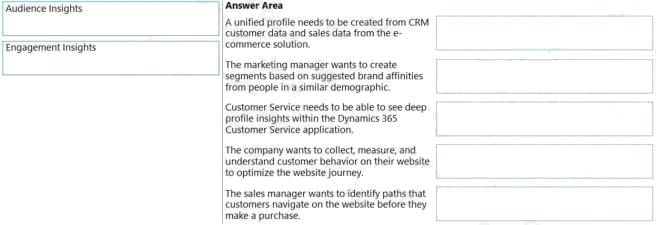
Answer:
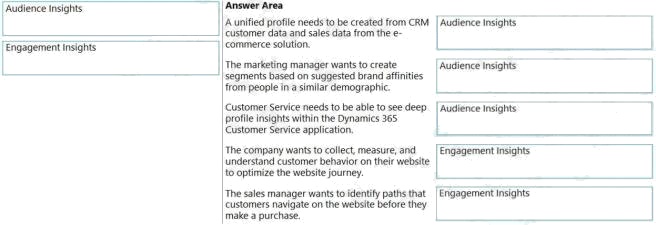
Explanation:
Reference: https://docs.microsoft.com/en-us/dynamics365/customer-insights/engagement-insights/overview
https://docs.microsoft.com/en-us/dynamics365/customer-insights/audience-insights/overview
Question 13 Topic 4, Mixed Questions
DRAG DROP
You are a Customer Data Platform Specialist. You are in the process of implementing audience insights as the Customer
Data Platform (CDP) solution for your company.
Your manager asks you to give a short presentation for new users who will be using audience insights and explain some of
the benefits that audience insights will offer them.
Which user group will take which benefit from audience insights? To answer, drag the appropriate user group to the correct
benefit. Each user group may be used once, more than once, or not at all. You may need to drag the split bar between
panes or scroll to view content.
NOTE: Each correct selection is worth one point.
Select and Place: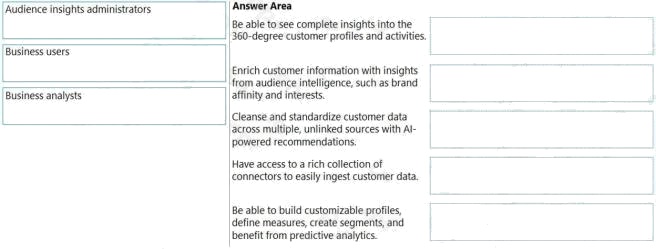
Answer:
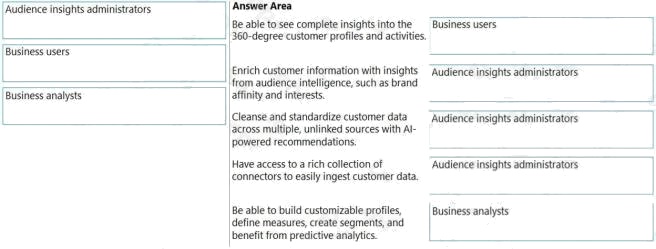
Explanation:
Reference: https://docs.microsoft.com/en-us/dynamics365/customer-insights/audience-insights/overview
Question 14 Topic 4, Mixed Questions
HOTSPOT
You are a Customer Data Platform Specialist. Your company has audience insights set up as their Customer Data Platform
(CDP). The product owner entered a user story on your backlog to add data from the new loyalty solution into the CDP. You
defined the data source. You are ready to add the loyalty contacts to the data unification process.
Which new data entity area should you select in the Map phase of the data unification process?
Hot Area: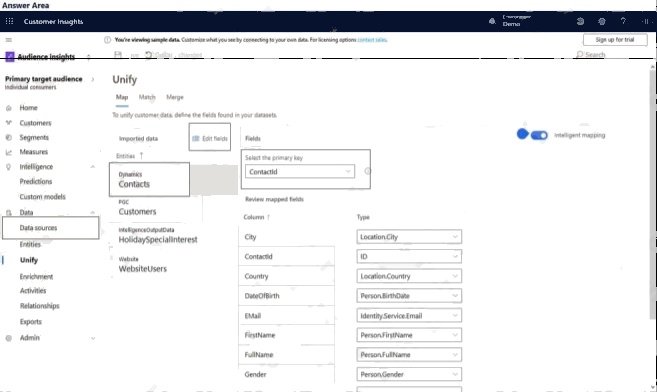
Answer:
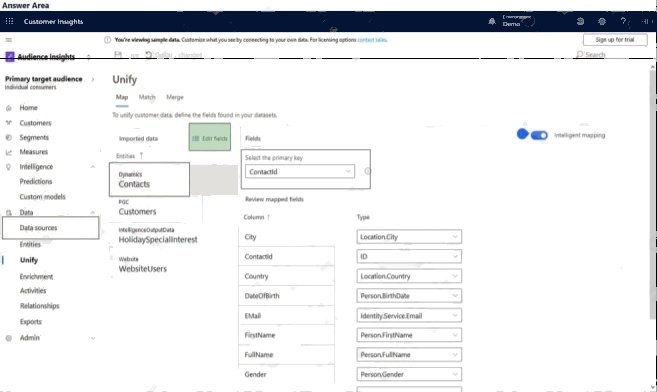
Explanation:
Reference: https://powerobjects.com/customer-insights/microsoft-dynamics-365-contacts-to-customer-insights/
Question 15 Topic 4, Mixed Questions
You are a Customer Data Platform Specialist. You completed all the steps in the match phase of the data unification process
in the audience insights. You need to review and validate your match results.
Which three metrics are available for you to validate the results? Each correct answer presents a complete solution.
NOTE: Each correct selection is worth one point.
- A. Unique matched records
- B. Matched records only
- C. Matched and non-matched records
- D. Unique source records
- E. All source records
Answer:
B C D
Explanation:
Reference: https://docs.microsoft.com/en-us/dynamics365/customer-insights/audience-insights/match-entities